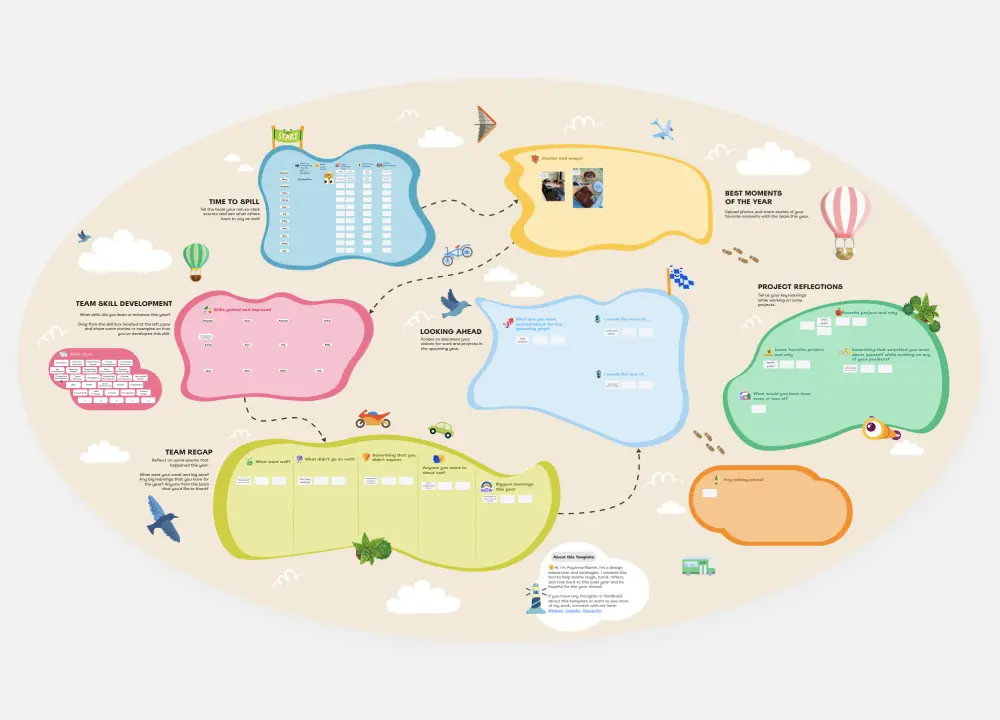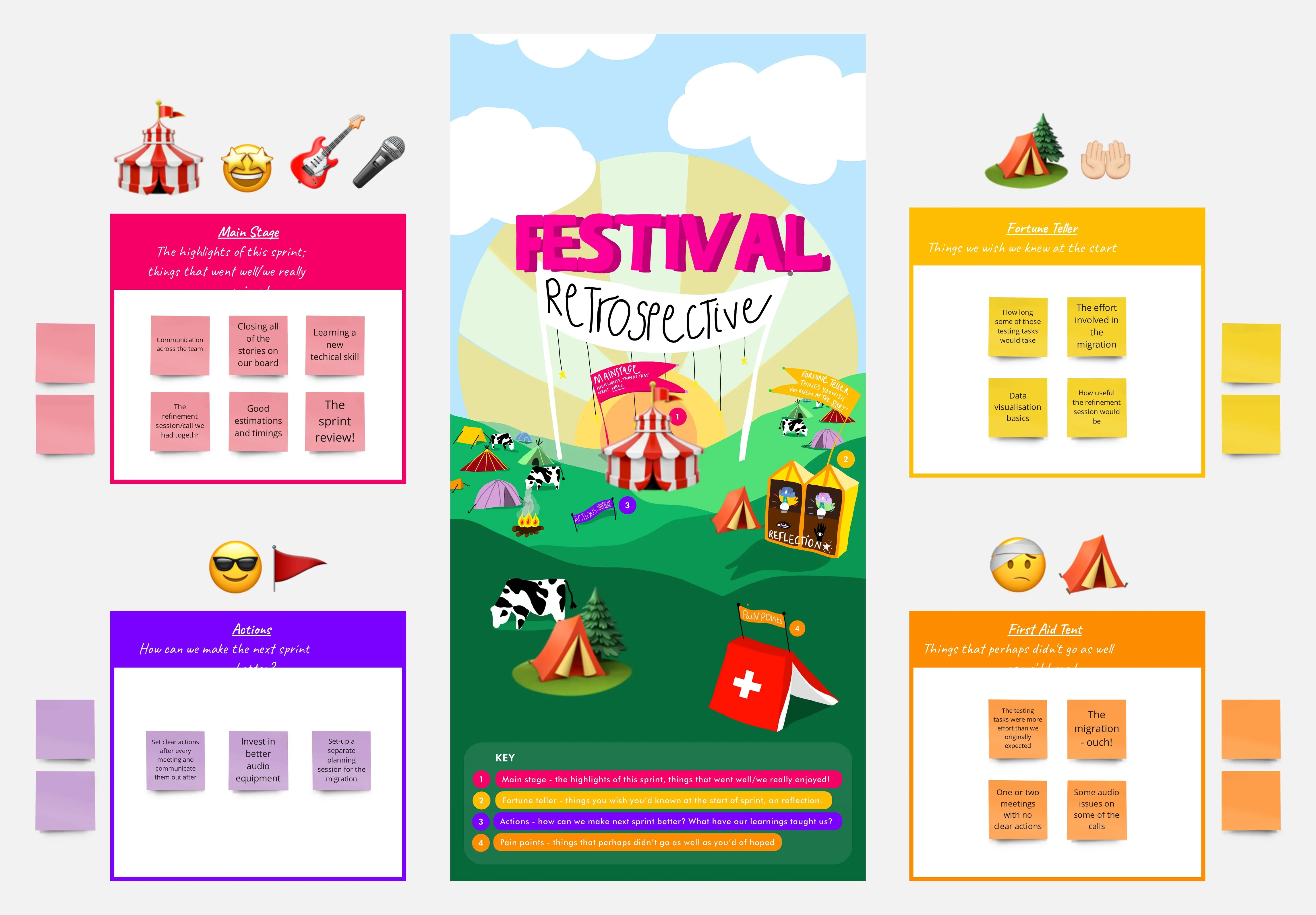Reflect on past performance and identify opportunities for continuous improvement with the Easter Egg retrospective template.
Guidance for use:
Stage 1 - Icebreaker
Get the conversation flowing with a tasty icebreaker where participants share an image of their favourite easter treat or snack with the group!
Stage 2 - Easter Egg Retrospective
Teams will then make their way around the board adding their thoughts and feelings while covering each of the themes listed:
- What were our tastiest Easter eggs?
What were our positives?
What went great?
- Which Easter eggs did you receive?
How did we support each other?
Where did you receive a helping hand?
- Are there eggs we're still looking for?
Was anything missing?
Could anything be done better?
- Give some eggs away!
Give an egg to someone who deserves it!
Who stood out this sprint?
Stage 3 - Dot Vote
Team members use their egg tokens to vote for the most valuable tickets that we're created and will lead to the most constructive steps moving forward.
Stage 4 - Rate the Retro
Once all areas of the board have been covered invite the team to rate the retro by placing a dot/ shape/ post-it on the appropriate rating from 1 (Waste of time) to 5 (Productive and engaging session)

Dave Westgarth
Digital Delivery Manager @ BJSS
Dave Westgarth is currently working as Head of Delivery @ UnifEye. He serves on software development, automation, cloud and AI/ ML projects across the spectrum of delivery approaches.
Categories
Similar templates
A Halloween Retro

A Halloween Retro
The Retrospective Halloween template offers a themed approach to retrospectives, perfect for the spooky season. It provides elements for reflecting on past iterations, identifying scary issues, and brainstorming solutions. This template enables teams to have fun while addressing serious topics, fostering creativity and collaboration. By promoting a playful yet productive atmosphere, the Retrospective Halloween empowers teams to tackle challenges, drive improvement, and strengthen team cohesion effectively.
Reflection Island: End of Year Team Retro

Reflection Island: End of Year Team Retro
The Reflection Island: End of Year Team Retro template offers a creative and themed approach to retrospectives, perfect for wrapping up the year. It provides elements for reflecting on achievements, challenges, and goals using a tropical island theme. This template enables teams to celebrate successes, learn from setbacks, and set intentions for the upcoming year in a relaxed and enjoyable atmosphere. By promoting reflection and celebration, the Reflection Island: End of Year Team Retro empowers teams to strengthen bonds, boost morale, and start the new year with renewed energy and focus effectively.
Festival Retrospective

Festival Retrospective
The Festival Retrospective template offers a unique and engaging approach to retrospectives by framing the session as a festive event. It provides elements for reflecting on past experiences, celebrating achievements, and setting goals for the future. This template enables teams to foster a positive and celebratory atmosphere, encouraging open communication and collaboration. By promoting a festive spirit, the Festival Retrospective empowers teams to strengthen bonds, boost morale, and drive continuous improvement effectively.
A Halloween Retro

A Halloween Retro
The Retrospective Halloween template offers a themed approach to retrospectives, perfect for the spooky season. It provides elements for reflecting on past iterations, identifying scary issues, and brainstorming solutions. This template enables teams to have fun while addressing serious topics, fostering creativity and collaboration. By promoting a playful yet productive atmosphere, the Retrospective Halloween empowers teams to tackle challenges, drive improvement, and strengthen team cohesion effectively.
Reflection Island: End of Year Team Retro

Reflection Island: End of Year Team Retro
The Reflection Island: End of Year Team Retro template offers a creative and themed approach to retrospectives, perfect for wrapping up the year. It provides elements for reflecting on achievements, challenges, and goals using a tropical island theme. This template enables teams to celebrate successes, learn from setbacks, and set intentions for the upcoming year in a relaxed and enjoyable atmosphere. By promoting reflection and celebration, the Reflection Island: End of Year Team Retro empowers teams to strengthen bonds, boost morale, and start the new year with renewed energy and focus effectively.
Festival Retrospective

Festival Retrospective
The Festival Retrospective template offers a unique and engaging approach to retrospectives by framing the session as a festive event. It provides elements for reflecting on past experiences, celebrating achievements, and setting goals for the future. This template enables teams to foster a positive and celebratory atmosphere, encouraging open communication and collaboration. By promoting a festive spirit, the Festival Retrospective empowers teams to strengthen bonds, boost morale, and drive continuous improvement effectively.